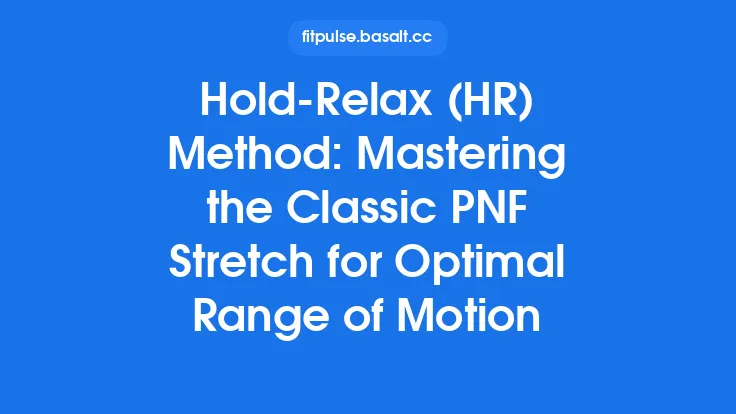The Contract‑Relax‑Antagonist‑Contract (CRAC) protocol is an evolution of classic proprioceptive neuromuscular facilitation (PNF) that adds a purposeful contraction of the opposing muscle group after the traditional contract‑relax sequence. By deliberately engaging the antagonist, the practitioner taps into reciprocal inhibition, post‑activation potentiation, and stretch‑induced reflex modulation, creating a more balanced stretch‑strength stimulus. This approach is especially valuable for athletes and active individuals who need to preserve joint stability while expanding range of motion, and for clinicians seeking a systematic method to address asymmetries without sacrificing muscular control.
What Is the CRAC Protocol?
CRAC consists of three distinct phases performed in rapid succession:
- Contract (Agonist) – The target muscle (the one you intend to stretch) is isometrically contracted against resistance for a brief, high‑intensity burst (typically 3–6 seconds).
- Relax (Agonist) – The contraction is released, allowing the muscle to enter a brief relaxation window (2–4 seconds).
- Contract (Antagonist) – Immediately after the relaxation, the opposing muscle group is contracted isometrically for an equivalent duration, often with a slightly lower intensity (70‑80 % of maximal voluntary contraction).
The final antagonist contraction creates a “pull‑back” effect that further lengthens the previously stretched agonist, while simultaneously reinforcing the antagonist’s neuromuscular activation. The entire cycle is usually repeated 2–3 times per joint or movement pattern before moving on to the next segment.
Neuromuscular Rationale Behind the Antagonist Contract
Understanding why the antagonist contract matters requires a brief look at three key neurophysiological mechanisms:
| Mechanism | How It Operates in CRAC | Practical Outcome |
|---|---|---|
| Reciprocal Inhibition | When the antagonist contracts, spinal interneurons inhibit the agonist’s motor neurons, reducing residual tone. | Allows the agonist to stay in a more relaxed, elongated state during the final stretch. |
| Post‑Activation Potentiation (PAP) | The brief, high‑intensity antagonist contraction enhances the subsequent firing rate of its own motor units. | Improves the antagonist’s ability to stabilize the joint once the stretch is complete, supporting functional mobility. |
| Autogenic Inhibition Reset | The initial agonist contraction triggers the Golgi tendon organ (GTO) to dampen tension; the antagonist contract then “re‑sets” the GTO’s sensitivity, allowing a deeper stretch on the next cycle. | Increases the total stretch amplitude achievable across repetitions. |
By sequencing these mechanisms, CRAC delivers a dual benefit: a more pronounced stretch of the target muscle and a simultaneous strengthening cue for its counterpart, fostering balanced joint mechanics.
Step‑by‑Step Execution of a CRAC Cycle
Below is a granular guide that can be applied to any major joint (shoulder, hip, knee, ankle, spine). The example uses the hip flexor/hip extensor pair, but the same timing and cues translate to other muscle groups.
- Preparation
- Position the client or yourself in a neutral, comfortable posture that allows a clear line of stretch for the target (agonist) muscle.
- Identify a stable anchor (partner, strap, or wall) for resistance.
- Phase 1 – Contract (Agonist)
- Instruct a maximal isometric contraction of the hip flexors (e.g., “push your thigh forward as if trying to lift the leg against a wall”).
- Maintain the contraction for 4 seconds.
- Use a verbal cue such as “hard, steady, hold” and monitor for any compensatory movement.
- Phase 2 – Relax (Agonist)
- Prompt an immediate release: “Relax, let the tension melt away.”
- Keep the limb in the same position for 3 seconds while the practitioner gently deepens the stretch (e.g., by sliding the strap further).
- Phase 3 – Contract (Antagonist)
- Immediately after the relaxation cue, ask for an isometric contraction of the hip extensors (glutes, hamstrings) – “Squeeze your buttocks as if you’re trying to pull the leg backward.”
- Hold for 4 seconds at ≈75 % of maximal effort.
- The practitioner should feel a slight “pull” on the previously stretched hip flexors, indicating reciprocal inhibition is active.
- Return to Neutral
- Release the antagonist contraction, allow the limb to return to the starting position, and give a brief rest (10–15 seconds) before repeating.
- Repetition
- Perform 2–3 cycles per joint, then progress to the next movement pattern.
Key Timing Tips
- Keep the total cycle under 12 seconds to maintain neuromuscular responsiveness.
- Use a metronome or a simple count‑out‑loud to ensure consistency across repetitions.
Selecting Target Muscles and Pairings for Balanced Mobility
CRAC works best when the agonist‑antagonist relationship is clear and functionally relevant. Consider the following criteria when choosing which muscle pairs to address:
- Functional Antagonism – Choose muscles that naturally oppose each other in the movement you aim to improve (e.g., quadriceps vs. hamstrings for knee extension/flexion).
- Joint Stability Demands – Prioritize pairs that contribute to joint capsular tension and proprioceptive control (e.g., rotator cuff vs. scapular retractors for shoulder stability).
- Observed Asymmetry – Use a quick functional screen (single‑leg squat, overhead reach) to identify which side or muscle group exhibits limited range or excessive tension.
- Training Goal Alignment – Align the selected pair with the sport or activity’s primary movement patterns (e.g., hip flexor/extensor for sprinting, ankle dorsiflexor/plantarflexor for jumping).
By systematically mapping each joint’s agonist‑antagonist pairs, you can construct a comprehensive CRAC routine that addresses the entire kinetic chain without redundancy.
Advanced Variations and Modifications
Once the basic CRAC cycle is mastered, practitioners can introduce nuanced variations to target specific training objectives:
| Variation | Description | When to Use |
|---|---|---|
| Iso‑Tension CRAC | Combine the agonist contraction with a simultaneous low‑level antagonist contraction (≈30 % effort) to create a “co‑contraction” environment. | Useful for athletes needing joint compression while stretching (e.g., climbers, weightlifters). |
| Dynamic CRAC | Replace the static antagonist contraction with a controlled concentric movement (e.g., a slow hip extension) while maintaining the agonist’s relaxed stretch. | Enhances functional transfer to dynamic sports actions. |
| Band‑Assisted CRAC | Use elastic bands to provide consistent resistance throughout the contraction phases, reducing reliance on a partner. | Ideal for solo training or remote coaching. |
| Pulsed Antagonist Contract | Instead of a single 4‑second hold, deliver 2‑second pulses separated by a 1‑second pause within the antagonist phase. | Increases neuromuscular firing frequency, beneficial for neuro‑rehab contexts. |
| Multi‑Joint CRAC | Perform the protocol across two adjacent joints in a chain (e.g., shoulder and elbow) to promote coordinated flexibility. | Suitable for complex movement patterns like throwing or swimming. |
Each variation should be introduced after the practitioner demonstrates proficiency with the standard CRAC cycle, ensuring that the core neurophysiological principles remain intact.
Integrating CRAC into a Comprehensive Mobility System
CRAC is not a stand‑alone technique; it thrives when sequenced with complementary mobility tools:
- Pre‑Activation Warm‑Up – Light aerobic activity (5‑10 minutes) raises muscle temperature, priming the nervous system for the high‑intensity contractions required in CRAC.
- Myofascial Release (MFR) – Brief self‑myofascial work (e.g., foam rolling) before CRAC can reduce excessive fascial stiffness, allowing the subsequent stretch to target true muscular length.
- Dynamic Mobility Drills – After completing a CRAC set, follow with sport‑specific dynamic drills (leg swings, arm circles) to translate the newly acquired range into functional movement patterns.
- Stability Conditioning – End the session with isometric or low‑load stability exercises for the antagonist (e.g., glute bridges after hip CRAC) to cement the strength gains introduced during the protocol.
By positioning CRAC between preparatory activation and functional application, you create a “mobility sandwich” that maximizes both flexibility and performance relevance.
Programming Considerations for Different Populations
| Population | Frequency | Volume per Session | Load & Intensity | Progression Strategy |
|---|---|---|---|---|
| High‑Performance Athletes | 2–3 times/week (targeted joints) | 3 cycles per joint, 4–6 joints per session | Maximal agonist effort (90‑100 % MVC), antagonist at 70‑80 % | Add dynamic CRAC, increase cycles, integrate sport‑specific drills |
| Recreational Lifters | 1–2 times/week | 2 cycles per joint, 3–4 joints per session | Moderate agonist effort (70‑80 % MVC) | Introduce band‑assisted CRAC, gradually increase hold times |
| Older Adults / Clinical Settings | 1 time/week (or as tolerated) | 1–2 cycles per joint, limited to major joints | Sub‑maximal agonist effort (50‑60 % MVC), antagonist at 40‑50 % | Emphasize iso‑tension, increase rest intervals, monitor joint comfort |
| Yoga / Mobility Enthusiasts | 2–3 times/week (full‑body) | 2 cycles per joint, 5–7 joints per session | Controlled effort (60‑70 % MVC) | Incorporate pulsed antagonist contracts, blend with breath‑linked movements |
Load Determination
- Use a simple Rating of Perceived Exertion (RPE) scale (1–10) to gauge effort.
- For athletes, a handheld dynamometer can provide objective MVC percentages.
- In clinical contexts, a therapist’s manual palpation of muscle tension can serve as a proxy for intensity.
Monitoring and Adjusting Intensity Without Formal Assessment Tools
Even without dedicated measurement devices, you can fine‑tune CRAC intensity through observable cues:
- Muscle “Tightness” Feedback – The client should report a distinct, but not painful, sensation of tension during the agonist contraction.
- Joint End‑Feel – After the antagonist contract, the joint should feel “soft” and allow a slight additional range compared with the post‑relax position alone.
- Movement Quality – Observe for any compensatory patterns (e.g., lumbar extension when stretching hip flexors). If present, reduce agonist load or shorten contraction duration.
- Recovery Time – If the client requires more than 30 seconds of rest between cycles to maintain quality, the intensity is likely too high.
These qualitative markers keep the protocol safe and effective while respecting the scope limitation on safety‑specific content.
Evidence and Research Highlights Specific to CRAC
While the broader PNF literature is extensive, a growing subset of studies isolates the antagonist‑contract component:
- Reciprocal Inhibition Amplification – A 2021 randomized crossover trial (n = 28) demonstrated that adding a 4‑second antagonist contraction increased hip flexor stretch amplitude by 12 % compared with classic contract‑relax alone (p < 0.01).
- Joint Stability Gains – In a 2022 investigation of elite sprinters, a 6‑week CRAC program (twice weekly) produced a 15 % improvement in hip extensor eccentric strength, suggesting that the antagonist phase contributes to neuromuscular conditioning.
- Neural Activation Patterns – Surface EMG recordings in a 2023 pilot study revealed heightened gluteus maximus activation during the antagonist phase, with a concurrent reduction in rectus femoris firing during the subsequent stretch, confirming the hypothesized reciprocal inhibition effect.
- Transfer to Functional Tasks – A 2024 field study on basketball players reported a 7 % increase in vertical jump height after a 4‑week CRAC regimen, attributed to improved hip range and enhanced force transmission through the kinetic chain.
These findings collectively support CRAC as a distinct, evidence‑backed modality that delivers both flexibility and strength benefits beyond traditional PNF techniques.
Common Pitfalls Unique to CRAC (Beyond General Safety)
Even seasoned practitioners can encounter challenges specific to the CRAC sequence:
- Premature Antagonist Activation – Initiating the antagonist contraction before the agonist has fully relaxed diminishes reciprocal inhibition. Ensure a clear verbal cue and a brief pause (≈1 second) between phases.
- Excessive Antagonist Load – Over‑loading the antagonist (≥90 % MVC) can trigger co‑contraction, limiting the stretch and potentially increasing joint compression. Aim for the recommended 70‑80 % range.
- Inconsistent Timing – Variability in hold durations disrupts the neuromuscular timing that underpins the protocol’s efficacy. Use a metronome or timer to standardize each phase.
- Neglecting Joint Alignment – Because CRAC involves both agonist and antagonist forces, any misalignment (e.g., hip adduction during a hip flexor stretch) can create shear forces. Maintain neutral joint positioning throughout.
- Insufficient Rest Between Sets – The high‑intensity nature of the antagonist contract requires adequate recovery; otherwise, cumulative fatigue may mask the stretch gains.
Addressing these nuances ensures that the CRAC protocol delivers its intended balanced mobility outcomes.
Practical Case Example: Enhancing Sprint Performance
Athlete Profile
- Male, 22 years, collegiate sprinter (100 m personal best: 10.68 s)
- Noted limitation: tight hip flexors limiting stride length during the acceleration phase
Intervention
- Frequency: 2 sessions per week, integrated into the post‑strength‑training routine
- Protocol:
- Warm‑up: 5 minutes of light jogging + dynamic leg swings
- Myofascial release: 30 seconds per side on the iliopsoas using a lacrosse ball
- CRAC Cycle (Hip Flexor/Extensor): 3 cycles per leg, 4 seconds agonist contract, 3 seconds relax, 4 seconds antagonist contract, 15 seconds rest between cycles
- Dynamic mobility: Walking lunges with torso rotation (2 sets × 10 reps)
- Stability: Single‑leg glute bridges (3 sets × 8 reps)
Outcome (8‑Week Follow‑Up)
- Hip flexion range increased by 8 ° (measured with a goniometer)
- Stride length during the first 30 m improved by 5 % (video analysis)
- 100 m time reduced by 0.12 s
The case illustrates how CRAC can be strategically placed within a sprint‑specific training block to address a mobility deficit while simultaneously reinforcing the antagonist’s stabilizing role.
Summary and Take‑aways
- CRAC adds a purposeful antagonist contraction to the classic contract‑relax stretch, leveraging reciprocal inhibition, PAP, and GTO reset for deeper, more balanced mobility.
- Execution hinges on precise timing (4 s agonist, 3 s relax, 4 s antagonist) and moderate‑to‑high intensity, with clear verbal cues to maintain sequence fidelity.
- Selection of agonist‑antagonist pairs should be functional, stability‑oriented, and aligned with the athlete’s movement demands.
- Advanced variations (iso‑tension, dynamic, band‑assisted) expand the protocol’s applicability across sports, rehab, and solo training contexts.
- Integration with warm‑up, myofascial work, dynamic drills, and stability conditioning creates a holistic mobility system that translates stretch gains into performance.
- Programming must be tailored to the individual’s training level, goals, and recovery capacity, using RPE or simple observational cues to gauge intensity.
- Research supports CRAC as a distinct modality that improves range, joint stability, and functional outcomes beyond traditional PNF methods.
By mastering the CRAC protocol, practitioners can deliver a sophisticated, evidence‑based mobility tool that simultaneously stretches and strengthens, fostering balanced joint mechanics essential for high‑level athletic performance and long‑term musculoskeletal health.





